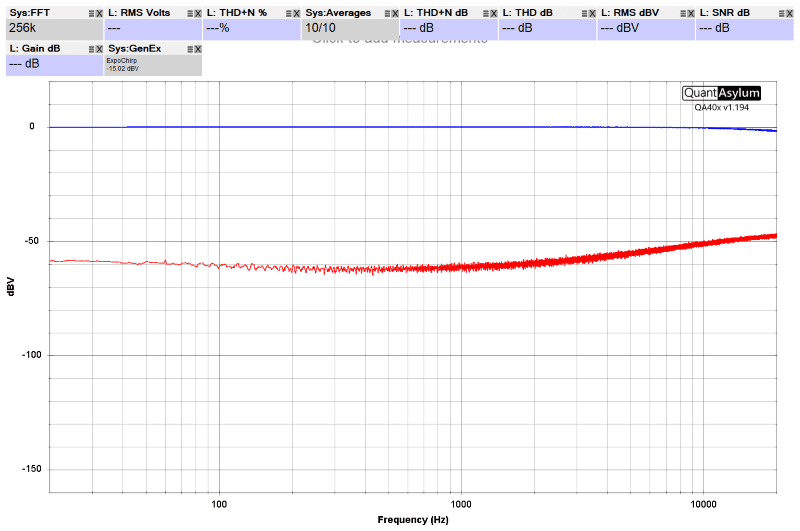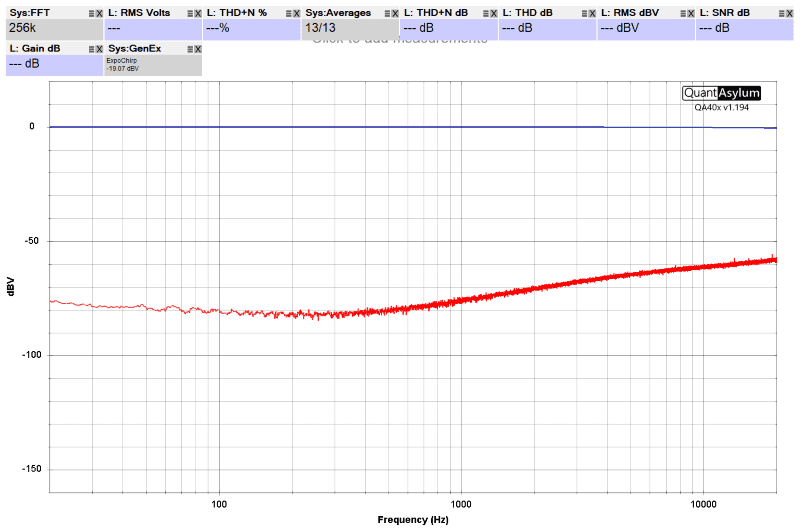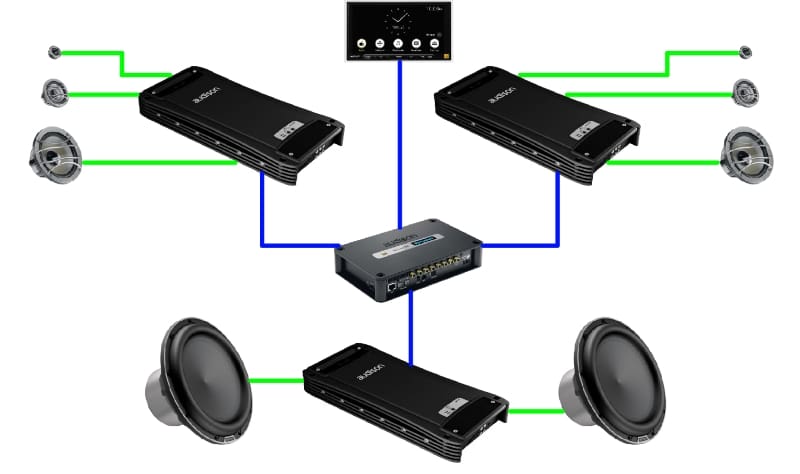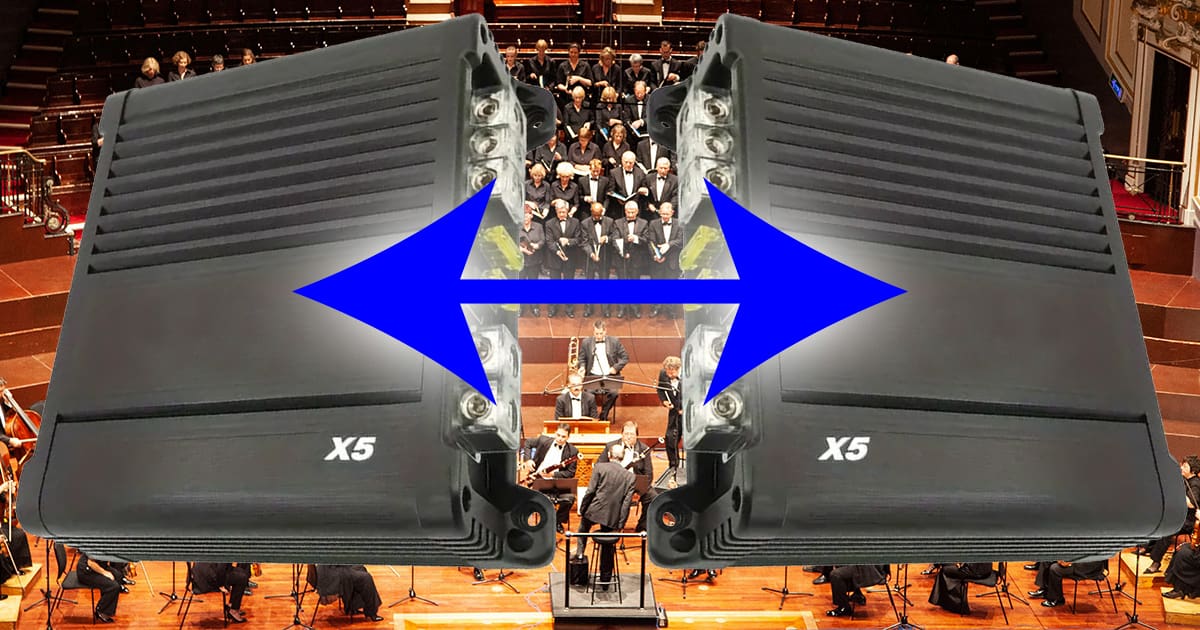So far, we’ve demonstrated five easily measurable criteria that separate the performance of one amplifier from another. Some of these, like frequency response, can be compensated for using an equalizer. Others, like harmonic and intermodulation distortion, are permanently baked into the amplifier’s sonic signature. Does the amp sound clean and transparent, or does it color the sound with warmth, harshness or some other unwanted characteristic? Moving into our sixth article, let’s talk about crosstalk and how it affects imaging and staging performance in an audio system.
What Is Amplifier Crosstalk?
Crosstalk, also known as channel separation, must be defined before measuring and quantifying its effect on a sound system’s performance. In short, this phenomenon is essentially the leakage of audio information from one channel of one amplifier to the other. For example, if we play a sound exclusively on the left channel, an ideal amplifier wouldn’t produce any of that sound on the right channel. Because amplifiers share many components like op-amps with both channels and often use capacitive coupling designs, signals can leak between the left and right. The leakage amount measured in decibels describes an amplifier’s channel separation performance.
In a worst-case scenario, as you’d find in a mono amplifier, all the signals from the left channel would be present on the right, and vice versa. When listening on a properly configured and calibrated audio system, all the music would seem to come from a single point in the center of the soundstage. This happens because the audio signals are equal in each channel.
In a perfect amplifier, perhaps as you’d experience when using two monoblock amplifiers in separate chassis, no amount of signal from either channel is transposed to the other side. If the system is configured correctly, this can produce a wide soundstage that extends to at least the vehicle’s limits. Only those signals equal in amplitude in the recording appear to come from the center of the soundstage.
It’s worth noting that other devices in the audio system will also exhibit differing amounts of leakage performance. A source unit or a signal processor shares many of the same components as an amplifier. As such, they can introduce some of this “more mono” behavior.
How We Measure Amplifier Crosstalk
Measuring the isolation between the left and right channels is relatively simple. There are two ways to perform this test. Some manufacturers or reviewers pick a specific frequency or two to measure, while others perform a sweep from the lowest of bass notes (20 Hz) to well beyond what humans can hear (20 kHz). We prefer the latter as it provides a detailed graphical representation of an amplifier’s performance.
The test method is simple: Play a sound in one channel set to a known reference output level (in our case, 0 dBV), then observe the output of the adjacent channel. Whatever is shown on the graph is unwanted audio information leaked through the amplifier’s circuitry. It’s best to measure leakage in both directions, as some amplifiers have better or worse performance one way or the other.
Channel Separation Measurements
We dug through our collection of amplifiers in the lab in hopes of finding extraordinary examples of excellent and poor performance. What we found was more of a comparison of mediocre and very good. Let’s start with a not-so-good measurement.

The graph above shows the output of the driven channel in blue and the crosstalk performance in red. The blue level has been set to 0 dBV, making it very easy to describe how much signal leaks to the adjacent channel. The red line shows just under 60 dB of leakage at the lowest frequencies, then dips to about 62 dB through the midrange before climbing to about 48 dB at 20 kHz. This is far from a disaster and would sound more than acceptable.

Now, let’s look at the performance of a much better amplifier design. This amp is about 18 dB better at low frequencies with 77 dB of isolation. The curve improves through the midrange, showing 20 dB better isolation at a level of about 82 dB through the midrange. As is typical of all stereo and multichannel amplifiers, the isolation drops at high frequencies at about -58 dB at 20 kHz. The separation is almost two orders of magnitude (20x) better across the entire audio range, with a single-order-of-magnitude (10x) improvement at high frequencies.
What Does Channel Separation Sound Like?
I recently compared the performance of a high-end Class AB and a high-end Class D amplifier for a car audio manufacturer. I test many products as part of the development process for many companies. This work is outside of the testing I do for BestCarAudio.com. It’s done under strict non-disclosure agreements, but I have permission to discuss what I hear in general terms.
I built a remotely controlled amplifier source switcher that allows me to instantly select the output of one amp or the other. This makes comparisons the easiest, as I can go back and forth mid-track quickly. Aside from some minor differences in tonal balance, of which I preferred the Class D amplifier on the particular speakers used, there was a noticeable difference in the soundstage size. This performance dramatically favored the Class AB amp. It’s worth noting that the amplifier’s topology (Class AB or Class D) does not contribute to this observation – crosstalk is mostly part of the preamp circuitry design.
I could easily hear that the soundstage was narrower, especially at higher frequencies. The instruments and performers were grouped tighter toward the center of the presentation. It detracted from the width and ambiance of the experience. I should be clear: Neither was a disaster, but one was better than the other.
Tricks to Improve Channel Separation
If you follow the car audio competition scene, you’ll notice that several competitors use similar designs in all the vehicles they build. One simple trick to improving channel separation is using separate amplifiers for the left and right front channels. There might still be some crosstalk in the source unit or signal processor. Separate left and right amplifiers maximize the separation downstream to deliver as wide a performance as possible.

Thoughts on Ideal Amplifier Crosstalk Specifications
I did a significant amount of research on channel separation in preparation for this topic. To my surprise, there’s a strong belief that only 25 dB of isolation is required for the presentation to be acceptable. From a purely scientific standpoint, this seems quite illogical. Consider an orchestra for a moment. If the violins are to the far left and the cellos are to the far right, why would we want any amount of that information presented on the opposite channel?
A leakage of 25 dB would be quite audible in the opposite channel, making a performer on the far left sound like they’re sitting closer to the center of the stage. Yes, there would still be a good stereo effect, but the size of the presentation would suffer. Channel separation should be as high as possible, with a number more like 50 dB being a good benchmark for minimum isolation.
Choose High-Performance Products for Your Car Audio System
It’s becoming harder and harder to find accurate information about audio components these days. Manufacturers typically omit channel separation specifications on their marketing documentation and their websites. We checked the websites of 10 reputable car audio amplifier manufacturers, and only one included amplifier crosstalk specifications. Even then, the numbers were only available in the owner’s manual for a single series of amplifiers. The days of car audio enthusiasts being able to look up the information they want seem to be long gone.
So, how would someone choose the right amplifier for their vehicle? Unlike bespoke high-end home audio retailers, you’re unlikely to have the opportunity to try the amplifier you have in mind for your vehicle before making a purchase. As such, listening to demo vehicles or even a display is often your only choice. You’ll want to focus on soundstage width, with music you’re intimately familiar with. If the system exhibits a soundstage that extends to at least the very boundaries of the listening environment, you’re likely in good shape regarding this single specification. If higher frequencies are clumped a bit toward the middle and not as wide as lower-frequency sounds, you might want to reconsider that amplification option.
When it’s time to buy a new amplifier for your car audio system, drop by a specialty mobile electronics retailer and ask for demonstration. Be suure to bring music that has great examples of extreme level and right panning and well-focused instrument placement. You can also compare different amplifiers on displays boards or in demo vehicles.
More From Our “Amplifier Differences” Series
- Part 1: Frequency Response explores how amplifiers handle different frequencies and how this affects the sound. It discusses the ideal of uniform amplification across all frequencies and examines how real-world amplifiers compare, using specific models for illustration.
- Part 2: Noise delves into the noise that amplifiers can add to the audio signal, how it’s measured, and its impact on sound quality. It explains the signal-to-noise ratio and how different amplifiers manage noise, including the effect of amplifier size on noise performance.
- Part 3: Harmonic Distortion discusses the concept of harmonic distortion, how it affects sound quality, and the performance of different amplifiers in minimizing it. It also touches on the distinction between even- and odd-order harmonics.
- Part 4: Distortion Versus Power Level and Frequency examines how distortion levels in amplifiers change with power levels and frequencies, highlighting the differences between high-quality and low-quality amplifiers in handling distortion.
- Part 5: Intermodulation Distortion focuses on intermodulation distortion, how it’s measured, and its effect on sound quality. It contrasts the performance of different amplifiers in managing IMD.
- Part 6: Car Audio Amplifier Crosstalk addresses how crosstalk between channels in an amplifier can affect the stereo imaging and soundstage of car audio systems, impacting the overall listening experience.

